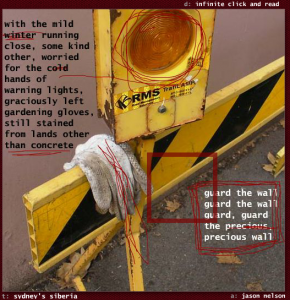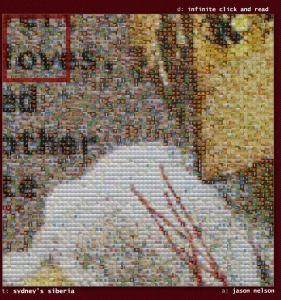There is currently a movement that is shifting the medium in which we read literature, from printed text to computer enabled literature. Electronic literature is relatively new and is still in the process of defining itself. The broader definition of electronic literature is currently, “work with an important literary aspect that takes advantage of the capabilities and contexts provided by the stand-alone or networked computer” (Electronic Literature Directory). In my opinion, this definition creates ambiguity as to what projects actually deserve or do not deserve literary merit for their work. The literary aspect is defined by Katerine Hayles in New Horizons for the Literary as “creative artworks that interrogate the histories, contexts, and productions of literature” (Hayles 4). The possible range in the scope of the literary within electronic literature is what makes this movement exciting. It gives writers and creators the flexibility to experiment and develop literary-focused projects that may fail to distinguish themselves as a electronic literature pieces, or may become projects that push perfectly far enough that they can essential redefine the classification boundaries of electronic literature. The extent to which the digital component can enhance the literary is limitless, and as there is further experimentation in this field, electronic literature will model itself under projects that are successful in intertwining the two aspects.
Not all projects are successful in aligning themselves under electronic literature, but one project that I enjoyed and molded under the electronic literature definition was Sydney’s Siberia. Jason Nelson produced this project while he was doing an arts residency in Newcastle. He took 121 different pictures throughout the city and created a poem. He used the use of infinite loops and zooming qualities that computers have, and created an infinite mosaic of the poem. Therefore, when you start the project on the internet, you have a small portion of the poem with a picture in the background and then you can zoom into the picture and find that the primary picture is actually comprised of tiny bits from a library of 121 pictures used in the poem and manipulated by variation of color to replicate just one of the pictures. You can zoom in forever, and you continue to discover all the 121 tiles within the poem.
This certainly fits into the definition of electronic literature, because the focus of the project is the literary aspect and the meaning behind the poem. However, the poem is complemented by the interactive design generated by the infinitely coded mosaic as the reader is also in control of determining which picture (with part of the poem) to view next. I liked some of the verses within the poem, but what I found most enjoyable about the electronic literature piece was the power I had in controlling the direction I took in reading the poem. This piece reminded me of Daytripper by Gabriel Ba and Fabio Moon, and it was all due to the use of computer coding in presenting the poem. The Daytripper chapters were not presented in chronological order, and I feel that this made the graphical novel more powerful and thought provoking.
In the same light, Sydney’s Siberia poem is not presented in order, and this creates a user-defined order (with repetitions or not). This allows for a unique experience for each individual user and for each individual occasion. Since this project was one of my to study, I must have started Sydney’s Siberia at least 20 plus times. Each time, I took a unique route and by doing so, I had a different interpretation in attempting to make a connection between picture and picture. This sort of project not only had the typical challenge for a reader to try and decipher the literary meaning behind the poem, but it also had the dynamic challenge to try and link the fragmented stanzas. This makes each interaction with the project an engaging academic challenge. Another task for the reader that I noticed was simply trying to determine where the poem might start and where the poem might end. Without the use of the computer capabilities to simulate fragmented and basically randomized poem stanzas, the poem would not be as engaging or powerful. Projects like Sydney’s Siberia use this trans-medial approach with the goal of developing these “simulative, emergent, and participatory models” (Hayles 17).
Critics may argue that these computer-generated features within the project do not align with the literary aspect behind the poem, or that these simulating features might distract or disrupt the literary. In response, I say that these features can develop in sync with the literary meaning behind the poem and its production. In Sydney’s Siberia, my belief behind the digital mosaic was that the creator wanted to demonstrate the thought process that goes behind making poems based on ordinary objects. Making a poem is not necessarily a completely linear development and a big challenge in formulating a poem comes from being able to organize your thoughts in a sequential order. I think the infinite mosaic reaches a deeper level, connecting the reader to the poet’s writing and thought process in developing such a poem. I think the idea is that any poet can have great thoughts and lines but that the figuring out how to link and make a successful poem has its own merit to it. This is reinforced by Janet Murray’s comments about the advantages to process transparency, “calling attention to the process of creation can also enhance the narrative involvement by inviting readers/viewers to imagine themselves in the place of the creator” (Hayles 16). Murray is actually discussing the transparency in the creation of the digital aspect of the projects but this relates to my point that maybe Nelson created this digital support to allow for transparency behind in the production of literary aspect itself.
This does not mean that all the digital aspects in projects related to electronic literature align themselves with enhancing the literary, or even that my interpretation of the digital aspect in Sydney’s Siberia was the actual purpose, but it speaks about the potential embedded in the digital aspects of these new projects. It also reinforces that electronic literature can produce powerful material that may reach higher levels of connection between the reader and writer that no printed based literature will ever be able to reproduce. Electronic literature is headed in the right direction, and it will be through more years of experimentation in this field that great projects, such as Sydney’s Siberia, will emerge.
Gould, Amanda S. “A Bibliographic Overview of Electronic Literature.” Http://www.directory.eliterature.org. N.p., 20 Apr. 2012. Web. 24 Oct. 2014. <http%3A%2F%2Fdirectory.eliterature.org%2Fnode%2F3706>.
Hayles, Katherine. “Electronic Literature: What Is It?” Electronic Literature: New Horizons for the Literary. Notre Dame, IN: U of Notre Dame, 2008.



